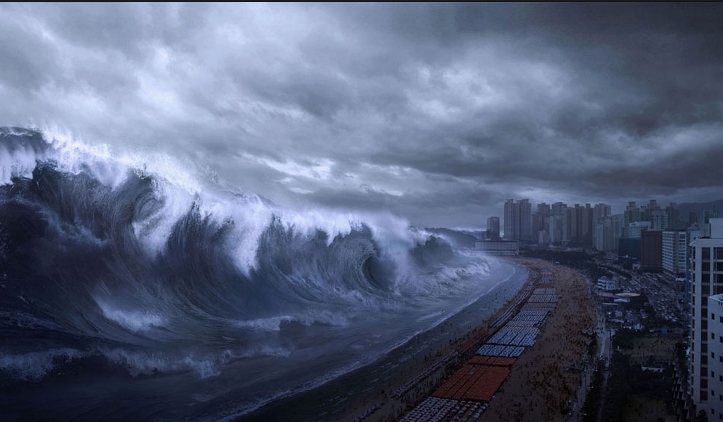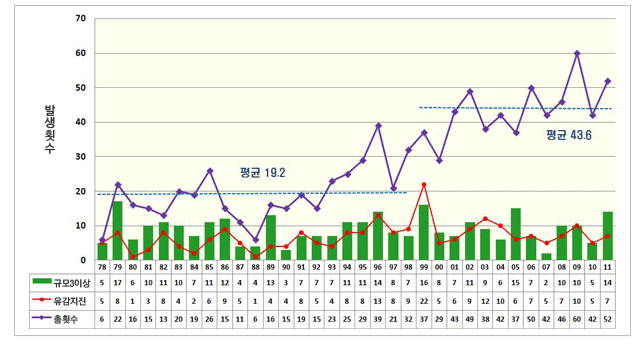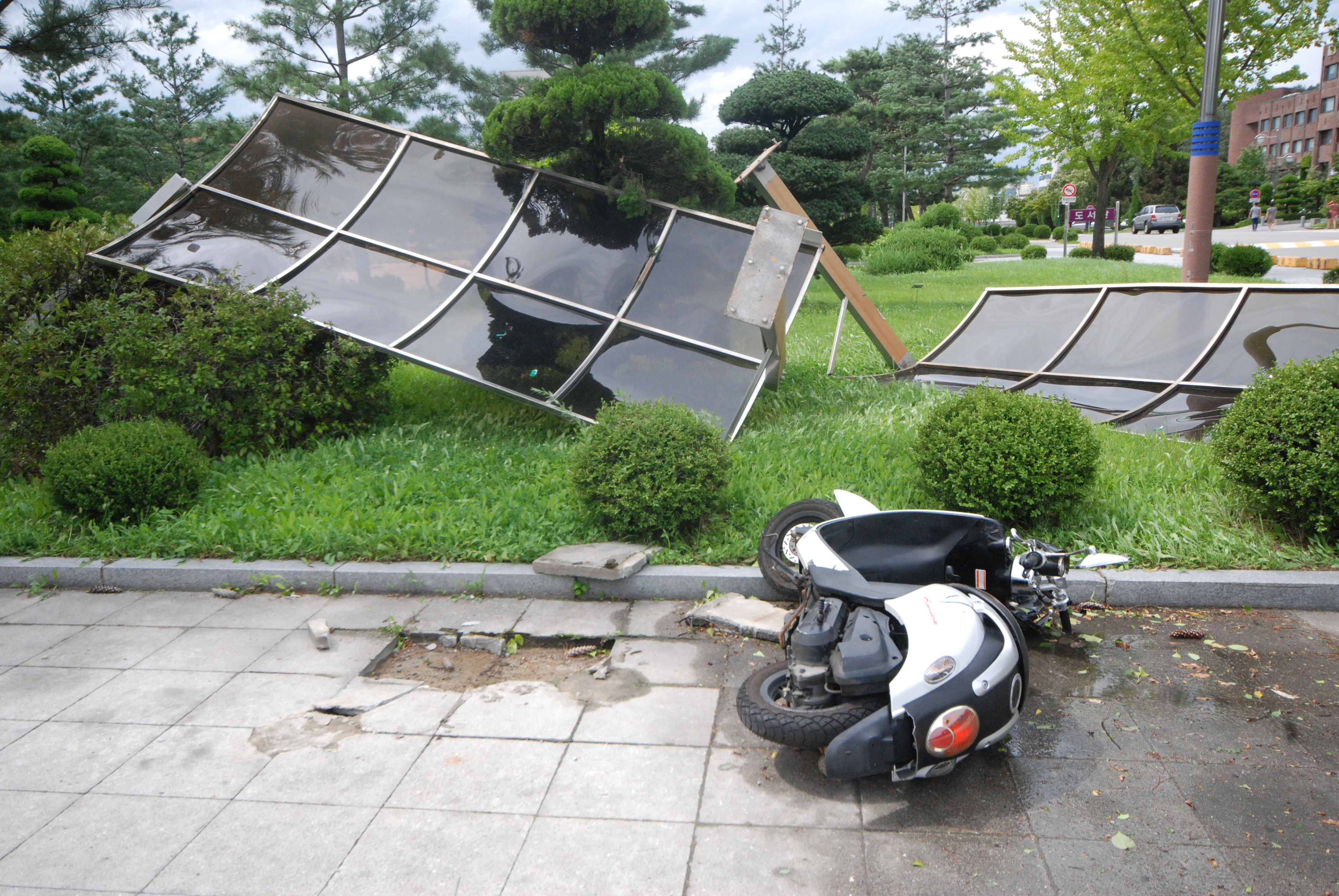
In a survey of 1,029 adults in the Disaster Science & Technology Special Committee, it showed many Koreans feel anxious about disasters. A result of the survey showed that Korean people said that they worried about damages by floods(39%), typhoons(37%) and earthquakes/tsunamis(28%). Thus, Chungbuk Times reported the current circumstances of Korea and other countries regarding natural disasters and examined some information from the National Emergency Management Agency(NEMA). -Ed

Is Korea a safety zone from earthquakes?
The Korean Peninsula had a total of 38 earthquakes up until August 2, 2012. The first earthquake, 2.0 on the Richter scale, happened in Pyongyang-si, North Korea on January 1. Earthquakes of more than 2.0 on the Richter scale were observed 32 times in our country, and earthquakes of 3.0 on the Richter scale were observed 6 times. The upper graph shows the number of earthquakes which have occurred in Korea from 1978 to 2011. The number of earthquakes has rapidly increased in our country since the 21st century.
Lee Young-wook, a junior of Incheon University, said, "I was taking a rest at home in Siheung-si, Gyeonggi-do. When I was at home, I suddenly felt my body shake, and I saw that objects were falling. I was scared because I have never experienced an earthquake, and the earthquake was short, but I was concerned whether I should run outside."
This shows that Korea is no longer in the safety zone of earthquakes. Therefore, the Korean government should urgently establish countermeasures and educate its citizens.
Earthquakes occurring internationally
On January 12, 2012, a 7.0 strong earthquake on the Richter scale killed 220,000 people and wounded 300,000 people in Port-au-Prince, which is the capital of Haiti. In the same year on February 27, an 8.8 strong earthquake killed 800 people in Santiago, Chile.
Comparing the Haiti and Chile earthquakes, Chile's was about 1.8 times of scale and 500 times of energy more massive than Haiti's. However, the number of deaths by the Haitian earthquake was about 275 times more compared with Chile's. The reason was the depth, which is the length from the ground to the area where the earthquake occurred. However, the main reason is that Chile always prepares for earthquakes contrary to Haiti.
In Chile, two million earthquakes occur every year, including some which people can't feel, because the country is located on the boundary between the Nazca Plate and the South American Plate. Because of this, the Chile Emergency Management Agency has a well-ordered organizing system which mobilizes firefighters and medical teams in a short period of time in case of an emergency.
In addition, the Earthquake Resistant Design is mandatory in all buildings. Thanks to it, many buildings didn't collapse despite the shock of earthquakes, so they can minimize the number of the wounded.

Typhoons lead to the most extensive damages among the natural disasters
The number of typhoons which have influenced Korea is 327 during the 107 years after starting the weather observation in 1904. An average of about 3 typhoons influence Korea in a year. The typhoons which form in February, August or September make up 90% of all typhoons in Korea.
Recently, more powerful typhoons are arising through the impact of global warming in comparison with the past. Typhoon Rusa in 2002 and Maemi in 2003 caused about six trillion won worth of damage each, because the maximum wind speed of the two typhoons reached 60m/s and they had a localized torrential downpour of 870mm a day. Meanwhile, Korea lacked abilities to deal with problems in various natural disasters. Some areas which are damaged by natural disasters every year are harmed all the time because they can't perfectly restore their assets before another disaster comes.
Typhoons occurring internationally
Two hundred Koreans died due to Maemi, while in Japan only one person died and ninety people were wounded. The press reported that the number of Japanese victims were few because Maemi hadn't directly reached the Japanese mainland. However, when the typhoon 'Guchol' reached Japan in June this year, only one person died and 74 were wounded.
Why did Japan have minimal casualties caused by the typhoons? They selected in advance the places which could be easily damaged by disasters like floods or typhoons. When natural disasters occur, residents who live in dangerous areas are informed to move to designated locations which are schools and public facilities. In addition, local polices personally patrol to prepare for landslides due to floods.
All Japanese people receive education which prepares them for natural disasters. The day is the Disaster Prevention Day. Korea has a Disaster Prevention Day on May 25, but only a few people in the military have the education.
The activities of the NEMA about the earthquakes
The NEMA became aware of the dangers of earthquakes, and it scheduled to adopt an Earthquake Early Warning System as soon as possible. It is a system which has received positive comments because it reduced harm when the great Japanese earthquake occurred. The system provides data using P waves and secures a few seconds before S waves reach, which causes serious damage. The Earthquake Early Warning System is a highly estimated modern earthquake preparation system which minimizes the damages of life and property. Furthermore, Korea is in the process of developing software about earthquakes and expanding the Standard Seismograph Network throughout the whole country.
The activities of the NEMA about the typhoons
The NEMA is trying to actively benchmark the precedents and countermeasures by developed countries. The developed countries are implementing standardization about natural disasters. However, disaster management in Korea isn't enforced and is arbitrary for each corporation and organization. That’s why the NEMA is scheduled to institute standards and handle methods about the management of natural disasters. In addition, they are reorganizing the law of Civil Engineering Structures to reduce damages caused by the typhoons.


 All
All Feature
Feature






 고아진
고아진











